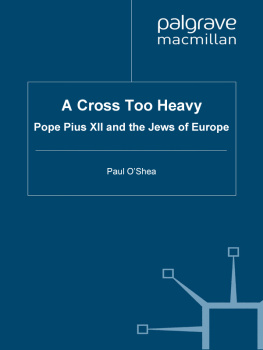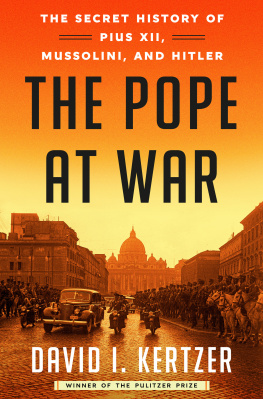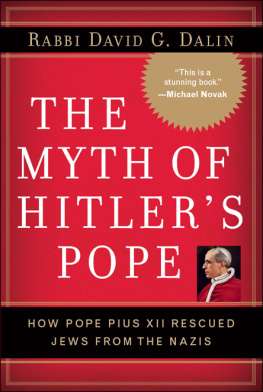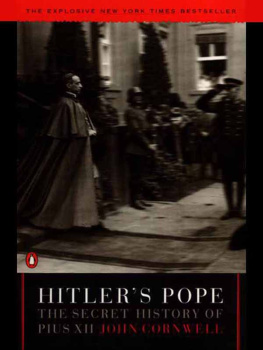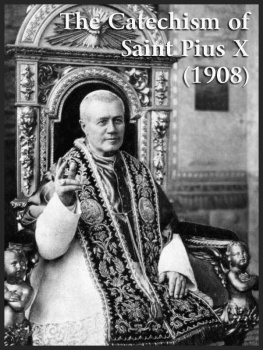A Cross Too Heavy
A Cross Too Heavy
Pope Pius XII and the Jews of Europe
Paul OShea


A CROSS TOO HEAVY
Copyright Paul OShea, 2011.
All rights reserved.
First published in 2011 by
PALGRAVE MACMILLAN
in the United Statesa division of St. Martins Press LLC,
175 Fifth Avenue, New York, NY 10010.
Where this book is distributed in the UK, Europe and the rest of the world, this is by Palgrave Macmillan, a division of Macmillan Publishers Limited, registered in England, company number 785998, of Houndmills, Basingstoke, Hampshire RG21 6XS.
Palgrave Macmillan is the global academic imprint of the above companies and has companies and representatives throughout the world.
Palgrave and Macmillan are registered trademarks in the United States, the United Kingdom, Europe and other countries.
ISBN: 9780230110809 (pbk)
ISBN: 9780230110793 (hc)
Library of Congress Cataloging-in-Publication Data
OShea, Paul Damian.
A cross too heavy : Pope Pius XII and the Jews of Europe / by Paul OShea.
p. cm.
Includes bibliographical references (p. ).
ISBN 9780230110793 (alk. paper)
ISBN 9780230110809 (alk. paper)
1. Pius XII, Pope, 18761958Relations with Jews. 2. Holocaust, Jewish (19391945) 3. JudaismRelationsCatholic Church. 4. Catholic ChurchRelationsJudaism. 5. Christianity and antisemitismHistory20th century. 6. World War, 19391945Religious aspectsCatholic Church. 7. National socialism and religion. I. Title.
BX1378.O74 2010
282.092dc22
2011000524
A catalogue record of the book is available from the British Library.
Design by Newgen Imaging Systems (P) Ltd., Chennai, India.
First edition: March 2011
10 9 8 7 6 5 4 3 2 1
Printed in the United States of America.
For Chris
CONTENTS
ACKNOWLEDGMENTS
This revised book grew out of research work undertaken for my doctoral dissertation, but quickly assumed a life of its own as more material came to light. Chief among the lessons I learned in writing this work is that I stand on the shoulders of giants, men, and women who have written in the field long before me and whose work has influenced, shaped, and critiqued my own.
Special thanks go to the library staff at the Catholic Institute of Sydney in Strathfield, one of the best resourced theological and Catholic historical libraries in the Southern Hemisphere. I must also acknowledge the help of the staff at Archivio di Stato di Roma, President Kennedy Library, Boston, the Library staff at the Australian National Library, and Macquarie University. Bishop Sergio Pagano and the staff at Archivio Segreta Vaticano (ASV) deserve special thanks for their accommodation of my requests, someone they have never met. The Internet has changed the way research is done. All my dealings with the ASV have been done online, and I acknowledge the professionalism and speed of the service rendered to me.
Over the years, I have engaged in conversation and correspondence with many academics. In particular, I wish to acknowledge the assistance given by Yehuda Bauer, Thomas Brechenmacher, John Conway, Deborah Dwork, Amy-Jill Levine, Michael Phayer, Alessandro Portelli, Matteo Luigi Napolitano, and Susan Zuccotti. Despite our agreements or disagreements they have, in their own ways, helped clarify areas for me, offered valuable advice and directed me to archives, documents, and other sources. It hardly needs saying that any errors in the text are my own and do not reflect on the caliber of the assistance so freely offered by a willing group of scholars.
Rabbi Eric Greenberg of the Anti-Defamation League helped open doors and opportunities in New York. Eric has become a good friend; his energy and encouragement have been a real mitzvah for me. Nothing is ever too great a problem. Lynne Rabinoff, my literary agent, has been a great support and I thank her for all she has done for me and for her courage in taking on this unknown writer from Down Under.
Writing is often a solitary and idiosyncratic pursuit and I must offer my gratitude and love to those closest to me who have endured more than their share of solitude. To Chris and the rest of the family, my love and thanks.
ABBREVIATIONS
| AAS | Acta Apostolicae Sedis: Commentarium Officiale |
| ADB | Akten Deutscher Bischfe ber die Lage der Kirche 19331945 |
| ADSS | Actes et Documents du Saint-Sige relatifs la Seconde Guerre mondiale |
| ASV | AES Archivio Segreta Vaticano, Affari Ecclesiastici Straordinari 19221939; followed by: |
| ANB Archivio Nunziatura Berlino |
| ANM Archivio Nunziatura Monaco |
| Baviera |
| Germania |
| Stati Ecclesiastici |
| AKF | Akten Kardinal Michael von Faulhaber 19171945 |
| Albrecht | Der Notenwechsel zwischen dem Heiligen Stuhl und der Deutschen Reichsregierung |
| Arad | Documents on the Holocaust |
| CC | Civilt Cattolica |
| CM | Catholic Mind |
| DBFP | Documents on British Foreign Policy |
| DGFP | Documents on German Foreign Policy |
| FRUS | Papers relating to the Foreign Relations of the United States |
| NARA | National Archives and Records Administration (Washington DC) |
| NYT | The New York Times |
| Times | The Times (London) |
Introduction
Pius XII, Catholics, Myths, and Realities
At what point does an experience precipitate a change in consciousness?
Professor David Bankier, Yad Vashem (March 8, 2009)
The Battles over Pius XII
On December 19, 2009, Pope Benedict XVI signed the Decree of Heroic Virtue for Pope Pius XII. The now venerable Pius XII was deemed to have lived an exemplary Christian lifenot a faultless one, but one that was indicative of a close communion with God in his vocation as priest, bishop, and pope. Responses varied from the triumphant to the tragic. Most focused on the papal actions and reactions during the Second World War in general, and on the Holocaust in particular. I suggest that the quality of many responses were indicative of deeper issues that lie beneath the surface of contemporary Catholicism. And as is so often the case when one peers beneath the surface, what is found is often unpleasant, challenging, and upsetting.
Benedicts signature on the Decree of Heroic Virtue was, for many, the latest in a series of Vatican public relations blunders that have stretched the credibility factor to the limit In 2007 the pope gave unrestricted permission for the use of the preVatican II Latin Mass, which included the Good Friday prayer for the conversion of the Jews. The ensuing kerfuffle led to Benedict composing a new prayer that left no one happy. Lifting the excommunication of the antiVatican II Lefebvrist bishops in January 2009 unleashed a storm of criticism over the splinter faction of extreme conservatives, who reject, among other Vatican II reforms, the idea of religious liberty, ecumenical and interfaith dialogue, especially with Jews. The storm worsened when it was revealed that one of the Lefebvrist bishops, Richard Williamson, was a known Holocaust denier. An unprecedented papal letter of apology to the worlds Catholic bishops did little to calm fears that a major reform of the reform was under way. And then in November 2010 Benedict made a series of very public
Next page
